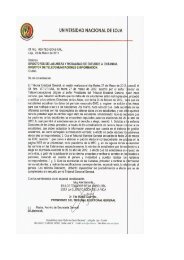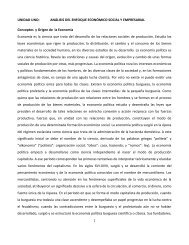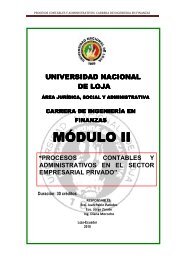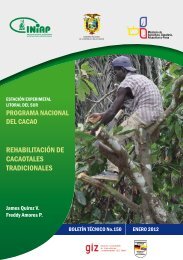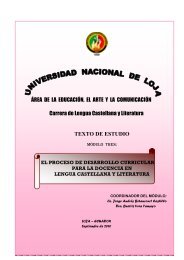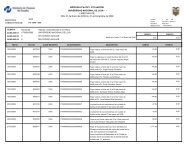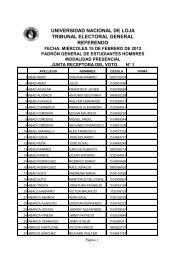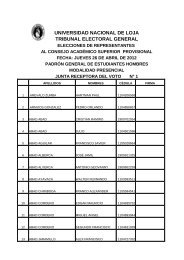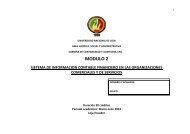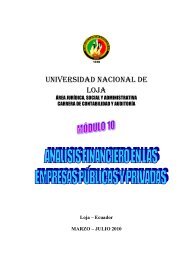module 5 planning of the english language teaching-learning process
module 5 planning of the english language teaching-learning process
module 5 planning of the english language teaching-learning process
You also want an ePaper? Increase the reach of your titles
YUMPU automatically turns print PDFs into web optimized ePapers that Google loves.
UNIVERSIDAD NACIONAL DE LOJA<br />
Área de la Educación el Arte y la Comunicación<br />
English Language Career<br />
Free communicative practice<br />
Characteristics and techniques: <strong>the</strong> variety and complexity <strong>of</strong> information <strong>of</strong>fers<br />
considerable choice <strong>of</strong> what to talk about.<br />
Speculation<br />
With <strong>the</strong> wallpicture made <strong>of</strong> magazine pictures-<strong>of</strong> animals (page 44), <strong>the</strong> students<br />
could be asked to identify <strong>the</strong> animals, to say where <strong>the</strong>y live and lo talk about <strong>the</strong>ir<br />
characteristics. The students can <strong>the</strong>n he asked to discuss broader issues such as, '<strong>the</strong><br />
relationship between <strong>the</strong>se animals and people', 'animal rights', animals' in history', and<br />
<strong>the</strong>ir own personal associations with <strong>the</strong>se animals.<br />
Story - telling<br />
In <strong>the</strong> picture <strong>of</strong> <strong>the</strong> street scene (page 44) <strong>the</strong>re is a great variety <strong>of</strong> information which<br />
could provide a basis for story-telling. Students rnight be asked to imagine what one <strong>of</strong><br />
<strong>the</strong> people is thinking or feeling and to write a short story about him nr her. The story<br />
could include reference to several places or o<strong>the</strong>r people in <strong>the</strong> picture.<br />
Technical tips<br />
1. The students al <strong>the</strong> back <strong>of</strong> <strong>the</strong> class must be able to see and recognize <strong>the</strong> details<br />
that you want <strong>the</strong>m to see. The only way to ensure this happens is to test it. As a<br />
general rule details must be about 2 cm in height to be seen <strong>the</strong> length <strong>of</strong> <strong>the</strong><br />
classroom. Never<strong>the</strong>less, testing is <strong>the</strong> only way <strong>of</strong> being sure.<br />
2. Teachers and students can make wallpictures by drawing <strong>the</strong>m and/or by sticking<br />
pictures from magazines, etc. on to <strong>the</strong> paper. Although <strong>the</strong> result is, by definition,<br />
amateurish <strong>the</strong> students are very likely to appreciate it as much or more than a<br />
commercially produced picture.<br />
3. The drawing style used must be almost diagrammatic with clear, simple outlines and<br />
simple colour - filled shapes ra<strong>the</strong>r than a sketchy, impressionistic style which is difficult<br />
to read.<br />
4. The easiest way to store wallpictures is o fold <strong>the</strong>m neatly, unless you have access<br />
to a map rack or shell.<br />
5. For more suggestions for drawing, mounting and displaying wallpictures<br />
[Escribir texto] Página 124



